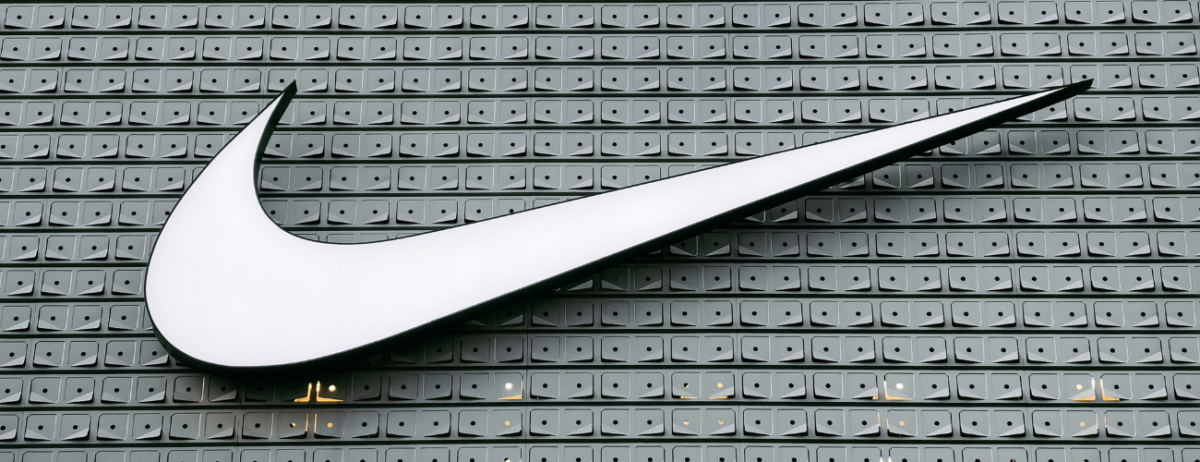Nike branding is on a league of its own. The iconic swoosh alone is a powerful symbol that’s become a household name all over the world. The “Just Do It” slogan rings a bell for many people. We haven’t even mentioned their signature shoes by their sponsored athletes yet! The brand has become just as iconic as a can of Coke and an Apple Macbook.
There’s no question that every brand wants what Nike has: instant and worldwide recognition. What brand doesn’t want those things, right? How can they achieve such success and maintain it for a long time?
Nike Branding Takeaways
Let’s take a marketing crash course and see what’s inside the Nike branding playbook. Take some cues from there and add them to yours!
#1: Brand positioning matters

What immediately pops into your head when someone brings up Nike? Shoes, right? As a brand grows, so does its association with a specific thing or trait.
Rule #1 of brand positioning is to start with a small segment or a specific niche. The smaller it is, the easier it gets for companies to click with their target audiences. Once you have the market on lock, growth follows from there.
We’re all well aware of Nike’s standing as a sportswear institution. It built its current identity by following its core principles as espoused by co-founder Bill Bowerman, who, by the way, was a former athlete himself:
A shoe must be three things: it must be light, comfortable, and it’s got to go the distance.
With that quote, you can immediately gauge the niche and audience he was going for. When Bowerman mentioned those points about Nike branding, it was during the late 1950s when quality running shoes were in short supply. Since he wasn’t satisfied with the available options, he sought to make the best pairs himself.
Little did he know that his philosophies would remain impactful in the future.
Those three points may sound simple, but they have and continue to define what a quintessential Nike shoe (and, by extension, product) is. Bowerman wanted every customer to think long and hard about their purchases; after all, they’ll be the ones to use them.
Position your brand by associating it with a specific quality or trait. For example, let’s say you’re selling organic skincare. Let potential customers know what your brand embodies and who’s it for.
#2: Stories make for compelling cases
One of Nike’s best strengths is its mastery of storytelling. Every ad they release always tells a tale about striving for something. Just take a look at the video above for reference.
The video, released last May 29, 2020, has Nike flipping its signature “Just Do It” slogan for a good reason. Decked in nothing but black and white, the ad uses blunt and direct language to send a message and stir action. It shows the company’s support and encourages people to actively participate in the fight against systemic racism, especially in the United States.
Nike understands how powerful stories are. They evoke a sense of belongingness for anyone. In the brand’s case, they want their audience to know that they’re capable enough of achieving incredible feats.
One great thing about Nike’s storytelling tactic is that they rarely mention their products in their ads. Instead, they go the emotional route. If you want your brand to appeal to its target audience, you can try your luck with this classic Nike branding strategy. But before you get to writing your narratives, ask yourself and answer these questions first:
- Why are you selling your products in the first place?
- What do customers automatically think about your brand the moment they hear about it?
- What are the physical and mental takeaways from your brand’s products?
Related: Apple Branding: The History of the Most Iconic Brand In the World
#3: Social media marketing is a must
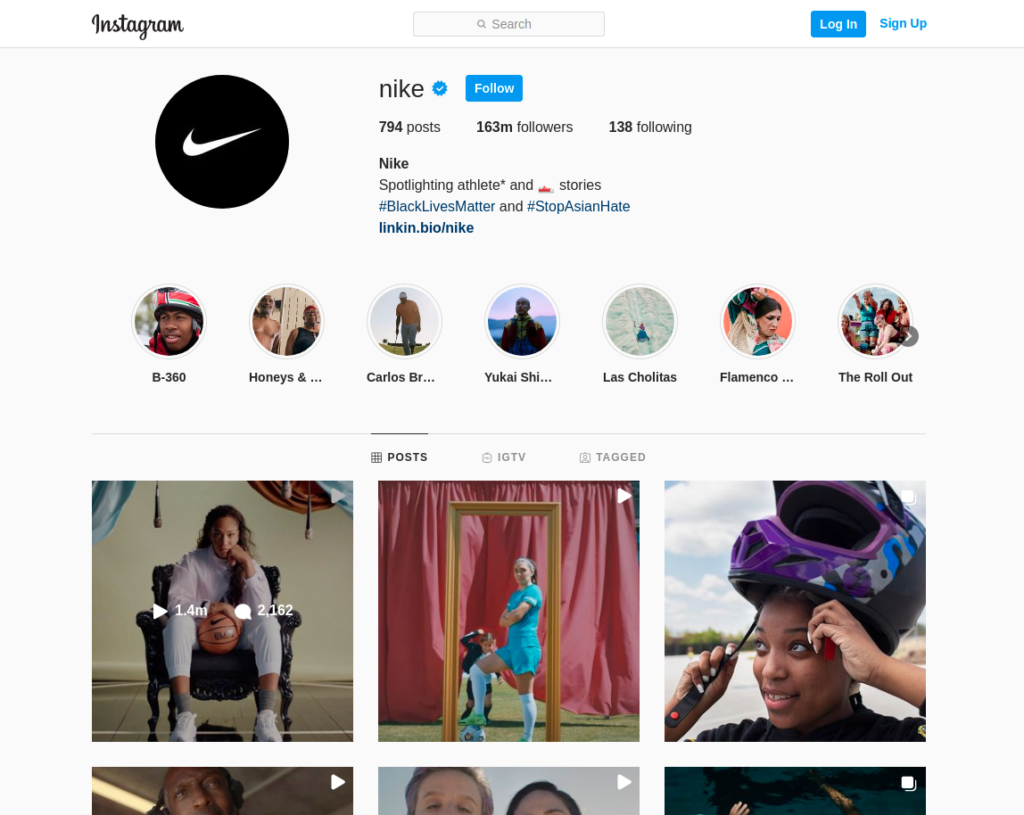
Most (if not all) of Nike’s customer base are active social media users. As marketing becomes more digital, so does online marketing as a necessity. People are on the internet, so why not go there, right?
Nike’s well aware of social media power—just take a look at their Instagram follower count! You know you’ve done something right on the marketing front when you’ve hit 163 million followers on a digital platform. The question is, how did they get such huge numbers?
For one, Nike’s Instagram profile posts user-generated content alongside its brand-curated ones. The Nike Women profile, in particular, features them every so often to appeal to their audiences. If you want your brand to have some relatability and authenticity, let users reveal what they want to say on your platform.
Two, Nike does collaborations. The brand works together with influencers and high-profile celebrities on specific posts to share their stories. The image below tells a tale of how an NGO founder got inspired by Milwaukee Bucks superstar (and newly-minted NBA champion and Finals MVP) Giannis Antetokounmpo’s ascent to greatness. Take a cue from this tactic and team up with a local hero to get your messages across.
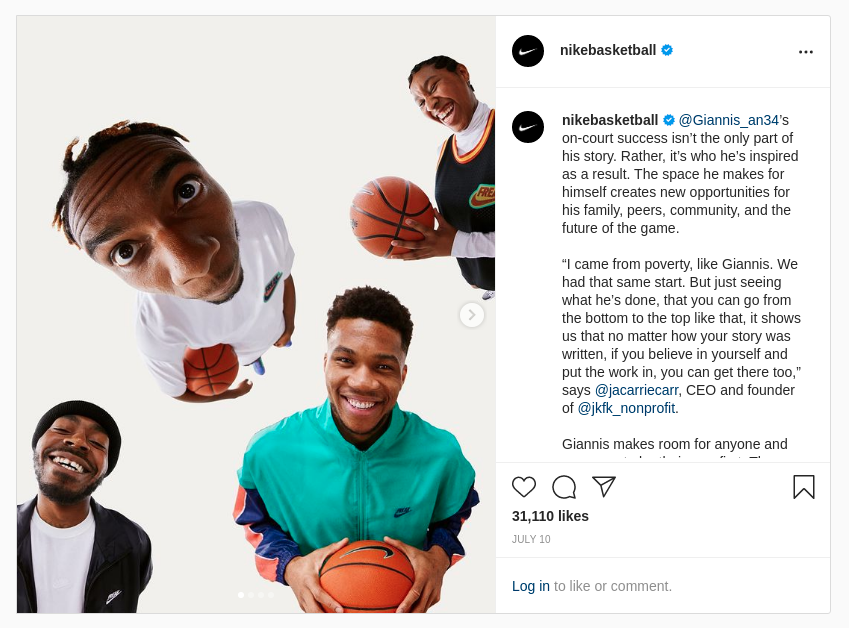
Three, they interact with their customers online. What’s the good in social media’s “social” part if there’s no interaction, right? Even one tweet from someone is genuine and organic feedback that’ll not only boost engagement numbers but reputations as well.
See the conversation below as an example. The brand knows that it doesn’t hurt to show a little Nike brand personality when talking to customers.
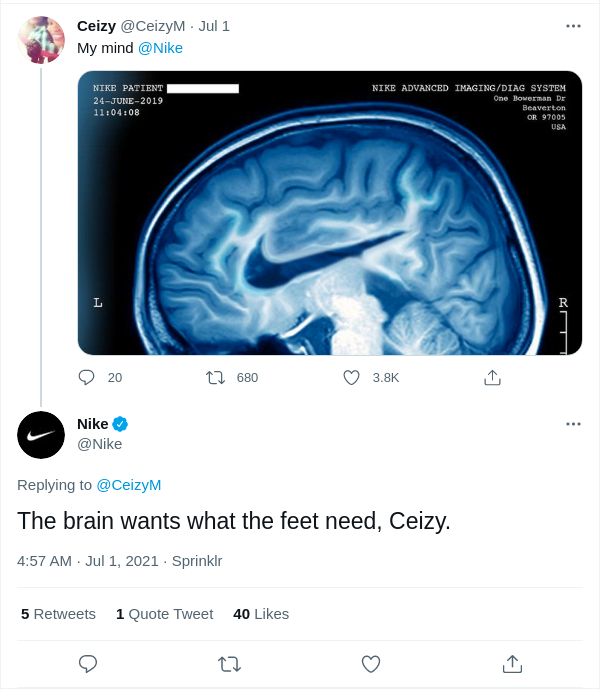
#4: Online shopping should be a breeze
Since COVID-19’s onslaught, people had no choice but to stay at home to steer clear of the virus. Brands faced many challenges as lockdowns hampered the retail industry hard. Even the Nike brand value deflated, losing over $4 billion last year.
Still, Nike was one of the many brands that strengthened its e-commerce front, capitalizing on the shift to direct-to-consumer (DTC) tactics. Its DTC sales made up around 33.1% of the company’s $12.34 billion revenue in 2020. With that huge number, their efforts are clearly working on that end. How has Nike remained strong despite challenging times? The answer: online shopping.
Although the world’s slowly opening back up, e-commerce remains a force. Here’s how Nike worked its magic on the internet.
Striking website design
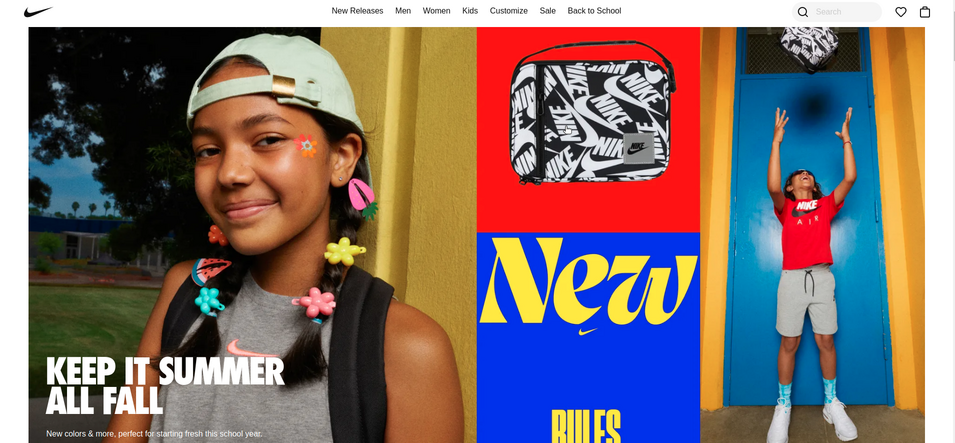
If you’ve seen Nike’s website (pictured above), you’ll notice that there isn’t much text on the content. The brand lets the photos do most of the talking. Bold fonts make people pay attention to what’s in front of them, stirring curiosity and interest.
Recommended items
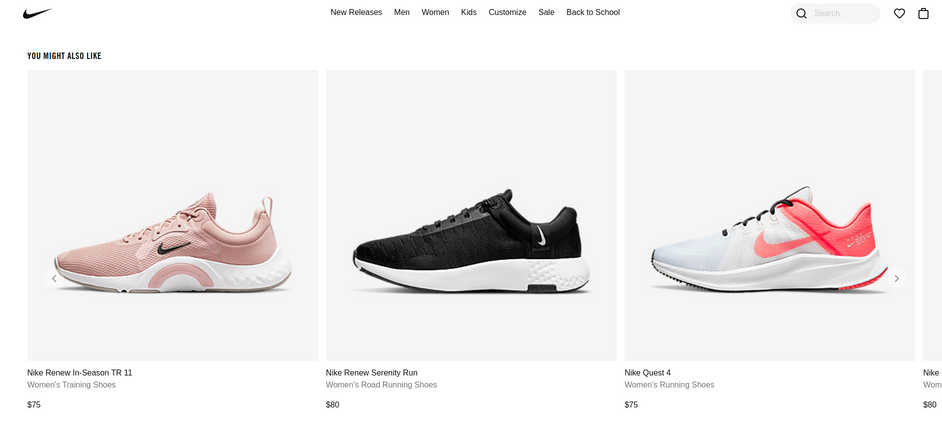
Another great thing about shopping at Nike’s online store is their recommendations. Whenever one browses an item, the site flashes a few products they think the customer will be interested in. The picture above shows a few women’s running shoes recommendations while checking out a specific model.
Product filters
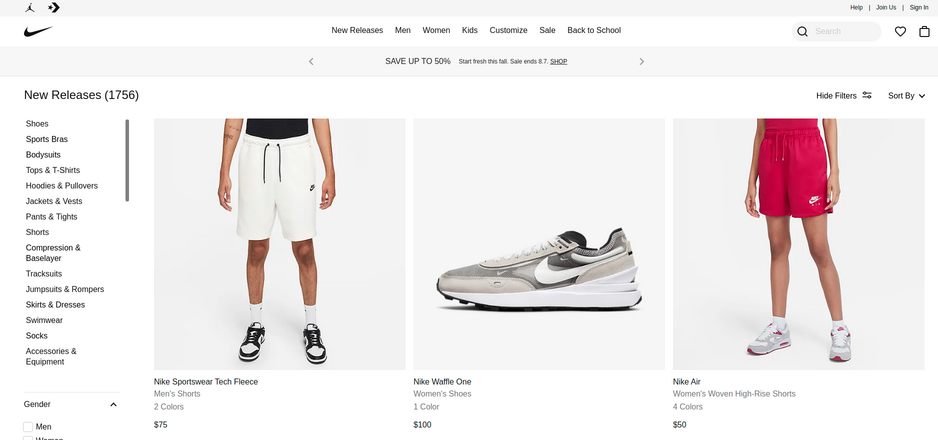
Notice the side panel on the image above? That’s Nike’s product filter. No need to open multiple tabs with this nifty feature around. Looking for a specific item type? No problem! Just sort your searches by checking the filters.
Have you got an e-commerce website or app? Add this handy feature to keep visitors coming and shopping!
Loyalty/rewards program

If you’re an e-commerce venture, you know how beneficial a loyalty/membership program is to your business. Not only does this tactic build a following, but it keeps it, too! It’s a win for everyone.
Nike’s loyalty program (NikePlus) is nothing to scoff at. When you have over a million members signing up for exclusives, you know whatever you’re doing is working. And the company makes sure its stays that way by making membership and loyalty part of their corporate growth strategies.
According to former CEO Mark Parker’s FY2019 letter, the membership program’s expansion is responsible for 35% of the brand’s digital revenue growth. He also gave members and memberships a shout-out six times. How’s that for audience recognition?
NikePlus focuses on access rather than the percentages and discounts, so customers are in for a treat. Here’s an example of such access: every season, Nike celebrates Member Days—an event where program members get benefits and exclusives for six days. Enticing, right?
Another perk Nike members get is that they receive gifts during birthdays and membership anniversaries. But wait, there’s more: they also get their personalized online Nike store that’s filled with recommendations based on purchase and engagement history.
And the best part? Loyalty pays off both on and offline. Customers’ memberships will be recognized whether they’re at a Nike store or just browsing through the app.
Want to craft your loyalty/membership program? Use Nike’s as an inspiration and work from there. You don’t have to copy every feature or suggestion, so feel free to insert original ideas into yours.
How to Apply the Takeaways
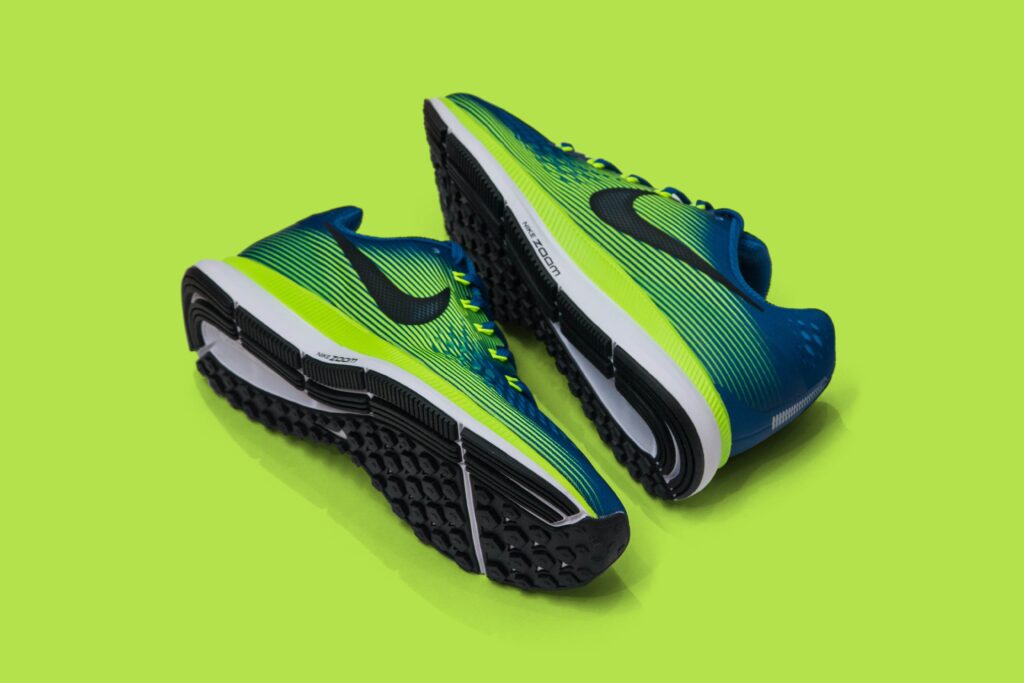
Now that we’ve got all the Nike branding takeaways down, here comes the application stage. How can you incorporate each one into your branding playbook?
#1: Discover and answer what your audience needs
Your audience is online because they’re looking for answers to their questions. Be the source they need by releasing compelling content that checks their boxes. If you pull this off, you may gain yourself a following.
Pro-tip: don’t put all of your focus into your brand’s advantages when marketing it. Instead, address your audience’s goals and present them with answers/solutions. Don’t forget to do your research before writing!
#2: Reach your target market
How do brands get in touch with their audiences? The answer: the internet. Luckily, social media channels have made it easier for any business to build an online presence.
But before you start signing up for profiles, consider your target audience’s preferences and habits. You know better than to go in blind on the internet.
#3: Keep the good content coming
And by that, we don’t mean daily updates.
Good content means posts that align with your target market’s needs. Get creative and don’t stick to text; go for infographics and videos for more visual flair. If you’re not on the same page with your audience, it’s best to back to the drawing board and revisit your tactics.
While we’ve covered most of the bases here, simply reading about Nike branding isn’t going to cut it. After all, what are theories for without application? Follow Nike’s lead and just do it!

